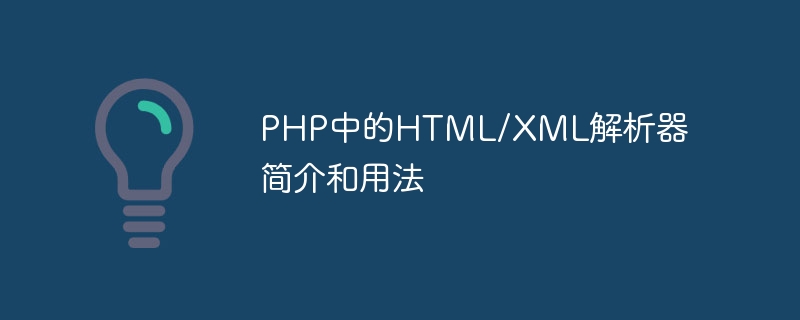Home >Backend Development >PHP Tutorial >Introduction and usage of HTML/XML parser in PHP
Introduction and usage of HTML/XML parser in PHP
- WBOYWBOYWBOYWBOYWBOYWBOYWBOYWBOYWBOYWBOYWBOYWBOYWBOriginal
- 2023-09-10 20:49:491333browse

Introduction and usage of HTML/XML parser in PHP
- Introduction
When developing web applications, it is often necessary to process HTML or XML documents . As a popular server-side scripting language, PHP provides a powerful HTML/XML parser, making processing these documents easier and more efficient. This article will introduce commonly used HTML/XML parsers in PHP and their usage. - HTML parser in PHP: DOMDocument
DOMDocument is a built-in class in PHP used to parse and manipulate HTML documents. It provides a series of methods and properties that enable you to easily load, browse and modify HTML documents.
The basic steps to use DOMDocument to parse HTML documents are as follows:
1) Create a DOMDocument object: $doc = new DOMDocument();
2) Load the HTML document: $doc-> ;loadHTMLFile('example.html');
3) Get the elements in the document: $elements = $doc->getElementsByTagName('div');
4) Traverse the elements and get their attribute values or text Content: foreach ($elements as $element) {echo $element->nodeValue;}
5) Modify the attributes or text content of the element: $element->setAttribute('class', 'new-class') ;
The advantage of the DOMDocument class is that it provides complete HTML parsing and manipulation functions. You can use it to obtain elements, attributes, and text content in the document and modify it. However, since the DOMDocument class loads the entire HTML document into memory, it may cause performance issues for large documents.
- XML parser in PHP: SimpleXML
SimpleXML is another built-in class of PHP that is used to parse and manipulate XML documents. It provides a simple and flexible way to process XML data.
The basic steps to use SimpleXML to parse XML documents are as follows:
1) Load the XML document: $xml = simplexml_load_file('example.xml');
2) Get the elements in the document :$elements = $xml->xpath('//element');
3) Traverse elements and get their attribute values or text content: foreach ($elements as $element) {echo $element->nodeValue ;}
4) Modify the attributes or text content of the element: $element->attribute = 'new-attribute';
The advantage of the SimpleXML class is that it uses a simple syntax to traverse and operate XML document. You can use the xpath() method to select an element with a specified path, and obtain or modify the element's attributes and text content through object properties. The SimpleXML class also provides some convenient methods, such as addChild() and addAttribute(), for adding child elements and attributes.
- Selection of HTML/XML parser
When selecting an HTML/XML parser, the choice should be made based on specific needs and document characteristics.
If you need to process large HTML documents, it is recommended to use the DOMDocument class because it provides more functions and operations. But be aware that using the DOMDocument class may consume more memory and CPU resources.
If you need to process simple XML documents or small HTML documents, the SimpleXML class is a better choice. It has a simple syntax, a lower learning curve, and is more flexible in terms of operation.
In addition, there are some other HTML/XML parsers to choose from, such as XMLReader and XMLWriter. They provide different parsing and manipulation methods, which can be selected according to your needs.
- Conclusion
The HTML/XML parser in PHP is an important tool for processing Web documents. DOMDocument and SimpleXML are two commonly used parsers. They are suitable for processing HTML and XML documents respectively, and provide a series of methods and attributes for parsing and manipulating documents.
When choosing a parser, you should make your choice based on your needs and document characteristics. DOMDocument is suitable for processing large HTML documents, but may consume more resources. SimpleXML is suitable for processing simple XML documents or small HTML documents.
By becoming familiar with and using these parsers, you can process and manipulate HTML/XML documents more easily, thereby developing web applications more efficiently.
The above is the detailed content of Introduction and usage of HTML/XML parser in PHP. For more information, please follow other related articles on the PHP Chinese website!

